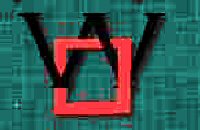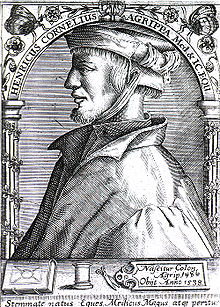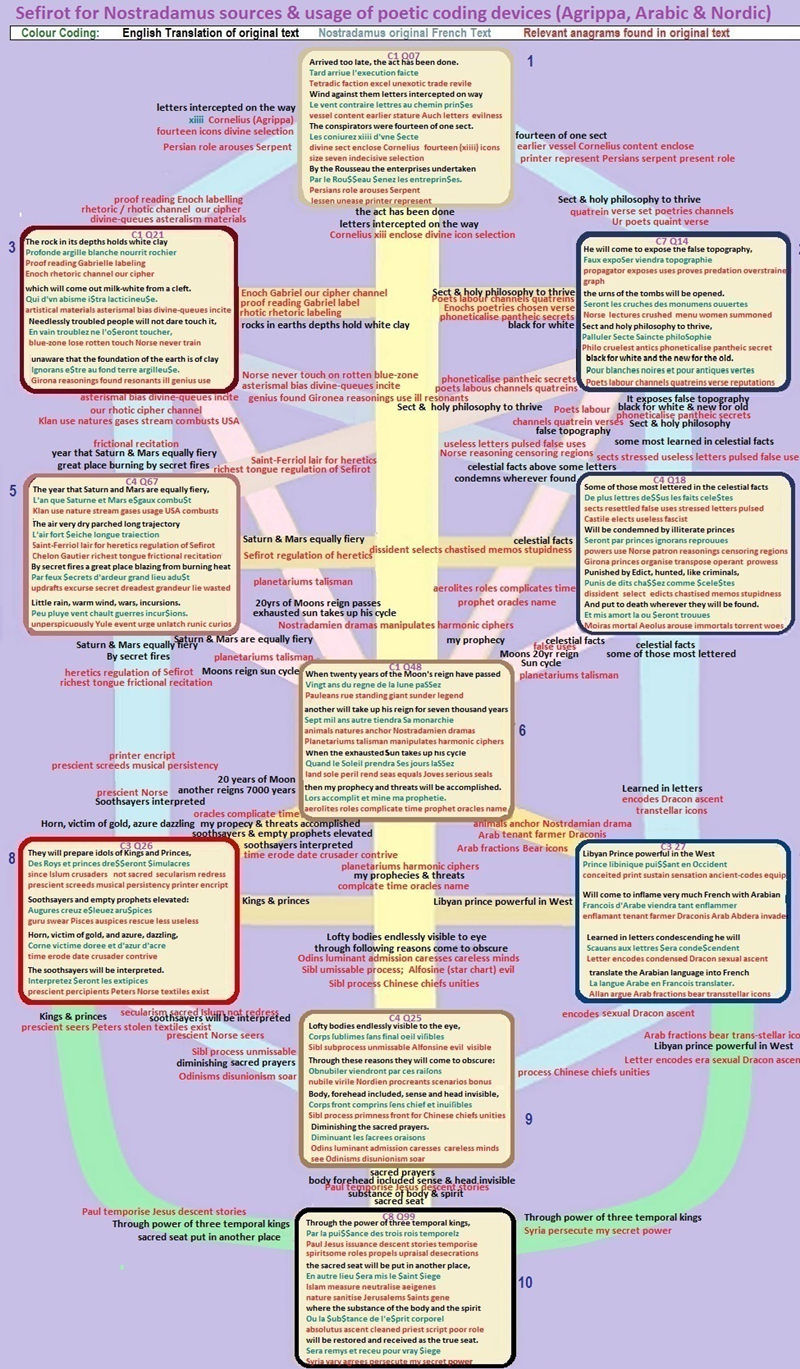 Analyses of all verses
Analyses of all verses
|
 Web Site
Web Site |
 All
Sefirots All
Sefirots |
NOSTRADAMUS on Agrippa© Allan Webber 2009 (sub -edited March 2012)See the following paper for the Rationale & Rules underlying my work on Nostradamus. |
Heinrich Cornelius Agrippa von Nettesheim (September 15, 1486 – February 18, 1535).
 Agrippa’s sixteenth century
works titled
Three Books Concerning Occult Philosophy
were arguably
the foremost references on the use of code and the meaning of symbols at
the time Nostradamus was publishing his prophecies. It was 22 years
earlier, at the time Nostradamus was in Agen, that the books for which
Agrippa is most well known were published. According to Wikipedia
:
Agrippa’s sixteenth century
works titled
Three Books Concerning Occult Philosophy
were arguably
the foremost references on the use of code and the meaning of symbols at
the time Nostradamus was publishing his prophecies. It was 22 years
earlier, at the time Nostradamus was in Agen, that the books for which
Agrippa is most well known were published. According to Wikipedia
:
De occulta philosophia libri tres (Three Books Concerning Occult Philosophy, Book 1 printed Paris 1531; Books 1-3 in Cologne 1533). This summa of occult and magical thought, Agrippa's most important work in a number of respects, sought a solution to the skepticism proposed in De vanitate.
In short, Agrippa argued for a synthetic vision of magic whereby the natural world combined with the celestial and the divine through Neo-Platonist participation, such that ordinarily licit natural magic was in fact validated by a kind of demonic magic sourced ultimately from God. By this means Agrippa proposed a magic that could resolve all epistemological problems raised by skepticism in a total validation of Christian faith.
Nostradamus' Interest
-
But understanding now, that of the seven Planets, Saturn, Mars, and the Moon have more of the voice then of the Harmony.
-
Saturn hath sad, hoarse, heavy, and slow words, and sounds, as it were pressed to the Center;
-
Mars, rough, sharp, threatening [threatening] great and wrathful words:
-
the Moon observes a mean betwixt these two;
-
Jupiter, Sol, Venus and Mercury, do possess Harmonies;
-
Jupiter hath grave, constant, fixed, sweet, merry, and pleasant Consorts;
-
Sol venerable, settled, pure and sweet, with a certain grace;
-
Venus lascivious, luxurious, delicate, voluptuous, dissolute and fluent:
-
Mercury hath Harmonies more remiss, and various, merry and pleasant, with a certain boldness:
-
-
but the Tone of particulars, and proportionated Consorts obeyed the nine Muses. Jupiter hath the grace of the octave, and also the quinte, viz. the Diapason with the Diapente: Sol obtains the melody of the octave voice, viz. Diapason; in like manner by fifteen Tones, a Disdiapason; Venus keepeth the grace of the quinte or Diapente. Mercury hath diatessaron; viz. the grace of the quarte..... Heinrich Cornelius Agrippa BK II Pt III Chapt xxvi:
One of the things that ensured these volumes were well read was that they served as a source for many types of ancient coding practices and it is this aspect, not the esoteric, that Nostradamus would have found invaluable for he needed a hidden reference to which he could direct the knowledgeable reader.
It is paramount that
Nostradamus' sources be
knowable but only by those intended to read his work. and this presents
great difficulties in the case where the writer can't communicate directly
and the recipients don't even know its meant for them.
The clues have to
be set in hints, supported by some hidden mechanism. If this is the case
one would expect such clues to be set early in Nostradamus' Prophecies. I
believe the seventh verse, Quatrain 7, Centuries I, holds the answers. I
believe that Nostradamus used the work of Heinrich Cornelius Agrippa whose
books on magic were published shortly before his own writings commenced.
However it would be incorrect to believe that his interest was in the
occult methodology encompassed by Agrippa's work.
I believe Nostradamus used Agrippa's work as a basis for the tables needed for setting the planet ciphers. It is from Agrippa's work that Nostradamus developed a code based on Agrippa's music formulas for the stars and translated these into musical sounds in the lettering of his quatrains. The basis for my assumption that Nostradamus' ciphers depend on music is founded on evidence within Nostradamus' Prophecies. An example of this is found in C6 Q100 which is discussed in several of my papers.
Pointers to places in Agrippa's works on Symbols and Coding Methods.
I have no doub t that Nostradamus embedded an obscure code in his work. In order for it to be useful he had to also embed clues that would lead to its decipherment. There are several verses that provide clues to use Cornelius Agrippa's works as a reference source. The clues are built in cryptic meanings in the text that cannot be resolved without using the anagrams interwoven into the lettering of the text. A prime example is C1 Q07
C1 Q07
Arrived too late, the act has been done.
The wind was against them, letters intercepted on the way.
The conspirators were fourteen of a sect.
By the Rousseau (red-haired one) shall these enterprises be undertaken.
Tard arriue l'execution faicte
Le vent contraire lettres au chemin prinses
Les coniurez xiiii d'vne secte
Par le Rousseau senez les entreprinses.Now in this verse the clues are easily missed. It is obvious that a number is embedded in L.3 but it adds little meaning as written by Nostradamus. However it is part of an anagram sequence that does give meaning " xiiii d'vne secte les coni" yields " XII iidvne sectele sconi" which leads to " XII divine celeste icons". And this means twelve divine heavenly icons. The word selection is also found as an anagram. In the first part of the line is the ultimate clue as to the reference point since the lettering 'Les coniur" is an anagram for Cornelius, the middle name of Heinrich Cornelius Agrippa.
A factor that closely links this verse of Nostradamus to the text on magic by Agrippa is to be seen in the location of the charts for 'the number twelve' in Agrippa's work. It occurs in Book II, Chapter XIIII, the number mentioned in the third line of the above verse by Nostradamus. It is worthy of comment that both Agrippa's Chapter heading and Nostradamus' verse use the same unusual form xiiii to write the number fourteen (Agrippa uses XIV in his contents page but xiiii for his heading).
There are other verses that support my conclusion. Of these the following is important since it bears the name of Agrippa in the form Henric- AGRIPPA, and Henric is a French variant of Agrippa's first name. This anagram occurs as A r AGRIPine cH = AAGRIPP- rine cH = AGRIPPA- Henric.C3 Q53When the greatest one will carry off the prize
Of Nuremberg, of Augsburg, and those of Bâle
Through Cologne the chief Frankfort retaken
They will cross through Flanders right into Gale.Quand le plus grand emportera le pris
De Nuremberg d'Auspourg et ceux de Basle
Par Agrippine chef Frankfort repris
Trauerseront par flamant jusqu'en Gal
Included in the English anagrams of this verse are:
Report.named.pasquiler (pasquiler =an extraordinary or unusual thing, person, or event; an exceptional example or instance.) poem.relates parentdom perils danger.
Base.guards.executed.numbered.group.
Henric-Agrippa appraiser enchiffre.rank.for pairs.report.
A.just.man alter.agen patron.treasure norse.part angel.queu's.
This is a significant amount of material in which the reader can detect meanings that are well outside normal expectations. Of course some of the simpler bits are likely to be false and this will also apply to some of the more complex sequences but despite this they form a formidable collection pointing to Agrippa especially where they are a reflection of the visible wording.
For example the third line carries the anagram Agrippar ENCHIFFRE through the lettering ar AgripINE CHEF FR and this correctly implies that Agrippa built a system of code but he also did it in the locations identified in the verse. The following facts can be read from the many references on Henric Agrippa available on the internet.
Agrippa was born at Cologne on 14 September 1486. He lived in Geneva from 1521–23 where the city licensed him to practice medicine. He also became city physician for the Swiss city of Frieburg in March of 1523-24. Frieburg is a town near Basle (i.e Bâle) . Agrippa was constantly in conflict with religious authorities throughout his life and it was not until 1530 that, while living in Flanders , he received permission to publish several important titles, including his treatise on magic De occulta Philosophia and De Vanitate. In 1530, Cornelius Grapheus of Antwerp printed the first edition of De Vanitate. The following year, Grapheus produced a partial edition (Book One) of De Occulta Philosophia. It was not until 1523 that this latter text was published. By this time Agrippa was once again living in Cologne.
ON CHOOSING THE REFERENCE POINT
Even though I am suggesting the source of Nostradamus' code is Agrippa's works the task of identifying Nostradamus' coding mechanism isn't as easy as it might now seem. Although it is probable that Nostradamus did rely on ancient Hebraic techniques mentioned by Agrippa this doesn't narrow the choice to any great extent. The reason for this is that the historical authorities are at odds with each other and with themselves and Agrippa mentioned and used many of these authors in his work.
However Agrippa is one of the authorities from which much material on Cabbalistic techniques has been developed and I have identified Chapter fourteen in Agrippa's second book on Occult Philosophy as being a likely source for Nostradamus. This chapter gives a table for the 'number twelve and in it he lays out the order of the Zodiac in a conventional manner. In other sections however Agrippa uses a different order.
There is a useful table at the end of Book One which sets out the value of the letter that corresponds with each Star-Sign and Planet. Agrippa presents it for The Hebrew and Greek lettering system but the numerology and the celestial assignation is totally different for both systems. Moreover Agrippa's Hebraic system has few links to the Sephir Yetzirah, the traditional source for much cabbalistic insight.
However I am spared the task of identifying which is right for my goal is to find Nostradamus' method. If, as I believe, he has identified a single source, it doesn't matter whether that source differs from others. After all I am looking for meaning supplied by Nostradamus not that applying to ancient or modern interpretations of the Jewish coding schemes. I don't believe Nostradamus used the content and methods from Agrippa but merely used the methods in these books to show the manner of thinking required to understand his method. They are exemplars not coding templates.
Chapter xiiii. Of the Number eleven, and the number twelve; with a double Scale of the Number twelve Cabalisticall, and Orphicall (from Agrippa's Occulta Bk II Part 2)

PLANET REFERENCE POINTS IN AGRIPPA.
Knowing of Nostradamus' allusion to music and its importance as a dating mechanism helps identify two key chapters in Agrippa's Occulta. Both of these generate a means of coding the planets in music and poetry. Agrippa's method is probably not the one used by Nostradamus but it is the clue to how it works.
Agrippa BK II Pt III Chapt xxvi: But understanding now, that of the seven Planets, Saturn, Mars, and the Moon have more of the voice then of the Harmony. Saturn hath sad, hoarse, heavy, and slow words, and sounds, as it were pressed to the Center; but Mars, rough, sharp, threatning [threatening] great and wrathful words: the Moon observeth a mean betwixt these two; but Jupiter, Sol, Venus and Mercury, do possess Harmonies; yet Jupiter hath grave, constant, fixed, sweet, merry, and pleasant Consorts; Sol venerable, settled, pure and sweet, with a certain grace; but Venus lascivious, luxurious, delicate, voluptuous, dissolute and fluent: Mercury hath Harmonies more remiss, and various, merry and pleasant, with a certain boldness: but the Tone of particulars, and proportionated Consorts obeyeth the nine Muses. Jupiter hath the grace of the octave, and also the quinte, viz. the Diapason with the Diapente: Sol obtains the melody of the octave voice, viz. Diapason; in like manner by fifteen Tones, a Disdiapason; Venus keepeth the grace of the quinte or Diapente. Mercury hath diatessaron; viz. the grace of the quarte:
The above passage illustrates how both music and poetry could be used to encode the planets by reversing the process so that these same sounds in a piece of work imply the presence of a planet. However without their location against the heavens it is not particularly useful but Agrippa's fascination with demon's provides a means for he links the names of demons to particular asterisms.
Book III Part 3 Chapter xxviii. How sometimes names of Spirits are taken from those things over which they are set.
I Finde yet another kinde of names given to the spirits from those things, which they are set over, their names being as it were borrowed from the Stars, or men, or places, or times, or such like things, the divine name being added at the end, thus. The spirit of Saturn is called Sabathiel: the Spirit of Jupiter, Zedekiel: the spirit of Mars, Madimiel: the Spirit of the Sun, Semeliel, or Semeschia; the Spirit of Venus, Nogahel; the spirit of Mercury, Cochabiah, or Cochabiel; the Spirit of the Moon, Jareahel, or Levanael. In like manner also they call the Spirits which are set over the signes by the names of the signes in order; from Aries Teletiel, Suriel, Tomimiel, Sartamiel, Ariel, Betuliel, Masniel, Acrabiel, Chesetiel, Gediel, Deliel, Dagymiel. And if we call them from the latin words, Ariel, Tauriel, Geminiel, Cancriel, Leoniel, Virginiel, Libriel, Scorpiel, Sagittariel, Capriel, Aquariel, Pisciel; and from the Planets, Saturniel, Ioviel, Martiel, Soliah, Veneriel, Mercuriel, Lunael, or Lunaiah.
It is evident that Agrippa can provide the reference needed by Nostradamus and given the contemporary relevance of Agrippa to Nostradamus and his period of writing it forms a credible base for us to explore. This will be my purpose in the remainder of this set of articles on Agrippa. We will be looking at how names and sound-values can be used to create dates in Nostradamus' poetry.
A quatrain that indicates the nature of this link is C1 Q42 which talks of Calendars and Demons and in its hidden anagrams ties together Agrippa and Nostradamus' poetry.
C1 Q42
The tenth day of the April Calends in the Gothic fashion
is revived again by wicked people.
The fire is put out and the diabolic gathering
seek the bones of the demon of Psellus.
Le dix Kalende d'Auril de faict Gotique
Resuscite encor par gens malins
Le feu eStainct affemblee diabolique
Cherchant les os du d'Amant et PSelin
The anagrams of the second line holds 'Centuries-process managers' scrutinizes names while the second has 'In affect' 'feel use fantastic oblique idea'. While the whole last line holds Agrippa's first name within 'Henric sole chant meant duads (pairs/couplets) spelt or something similar. (First line may suggest pre-Gregorian chant i.e. Roman chant or plainchant).It is clear that there are unusual connections here and we will return to see more within this quatrain as I present other verses of relevance.
I have no doub t that both music and poetry can be encoded to carry a hidden message. All that is needed is that a system of importance be in place for certain values and for both the sender and receiver to be aware of the system. Given this an expert receiver can be capable of receiving and interpreting that which seems impossible to the ordinary person. We know of such skills, Gymnasts, musicians, conjurers, mind-readers and magicians employ them in their craft, creating abilities that bewilder the lay person. There is no magic involved, only knowledge and intensive practice.
However the first task is to show that such a classification is possible enabling Agrippa's writings on planets to be applied to Nostradamus' Prophecies.
There are three dimensions that Agrippa uses to set the planets and these are musical quality (harmony vs voice), letter quality (smoothness vs roughness or hardness of sound), simplicity of sound (letter grouping).
Musical quality: In music harmony is the use of simultaneous pitches (tones, notes) or chords. Harmony is often said to refer to the "vertical" aspect of music, as distinguished from melodic line which provides the "horizontal" aspect. In poetry we are looking at rhyme and equivalence of sounds versus the order of sounds (voice) the difference being their repetitiveness. The following are examples from the lists I produce using a computer analysis of all lines in the Prophecies.
| Harmony (equivalence of sound) | Voice (order of sound) |
| C8 Q43 L.4
Nepueu par peur pleira
l'enSeigne C8 Q02 L.4 Fouldre grand gresle mur tombe dans Garone C5 Q53 L.1 La loy du Sol et Venus contendens |
C6
Q74 L.1 La
deSchaSSee au regne
tournera C4 Q31 L.2 Le nouueau Sophe d'vn seul cerueau l'a veu C1 Q20 L.4 Fleuues dards Renes terre et mer tremble. |
Agrippa also distinguishes the quality via other independent properties examples for which are given below.
Letter quality: The manner in which the prominent consonant sounds are produced determines the smoothness or harshness of the line.
| Smooth/ Soft c f j h l m n r s t y | Hard/Harsh/Sharb cc d g k q rr t v z |
| C4 Q31 L.2
Le
nouueau Sophe d'vn seul cerueau l'a veu C5 Q81 L.1 L'oiseau royal Sur la cite Solaire C3 Q29 L.1 Les deux nepueux en diuers lieux nourris |
C8 Q2
L.4 Fouldre grand
gresle mur tombe dans
Garone C1 Q20 L.4 Fleuues dards Renes terre et mer tremble. C3 Q66 L.2 Sera par vn de Sang vindicatif |
Simplicity quality: The simplest groupings involve a set of regularly alternating single vowels and consonants. Complexity occurs where there is a regular extension or removal of either a consonant or vowel sound.
| Simple | Complex |
| C5
Q53
L.1 La loy du Sol et Venus contendens C4 Q31 L.2 Le nouueau Sophe d'vn seul cerueau l'a veu C3 Q29 L.1 Les deux nepueux en diuers lieux nourris |
C1 Q20
L.4 Fleuues dards Renes
terre et mer
tremble. C8 Q02 L.4 Fouldre grand gresle mur tombe dans Garone C6. Q74 L.1 La deSchaSSee au regne tournera |
The above provides the means to use Agrippa's classification of the planets.
| Agrippa's description of the planets. |
|
|||
| Jupiter is more of the Voice and has grave, constant, fixed, sweet, merry, and pleasant Consorts |
|
|||
| Mars is of the Voice and has rough, sharp, threatening, great and wrathful words |
|
|||
| Moon is another of the Voice and lies between Jupiter and Mars. |
|
|||
| Saturn has Harmony + sad, hoarse, heavy, and slow words, & sounds, as it were pressed to the Centre. |
|
|||
| Venus is once more based in Harmony, it is lascivious, luxurious, delicate, voluptuous, dissolute and fluent. |
|
|||
| Mercury has Harmonies more remiss and these are various, merry and pleasant, with a certain boldness. |
|
|||
| Sol has Harmonies and these are venerable, settled, pure and sweet, with a certain grace . |
|
In earlier work I have shown that the mysterious verse, Centuries 6, Quatrain 100 holds secrets of the code and that its emphasis is on using music. Its header calls the verse an incantation while its second line contains the hidden message Neat proof a num(ber)-valu(e) guest in music (0 Prof - anum- vul - guset - i n -Scium - neat). I have also shown previously that Nostradamus states in the documents that preface his prophecies that he set a code into the verses based on the planets.
When I realized that Agrippa’s work was Nostradamus source for his coding methodology the certainties stated above alerted me to the import of Agrippa’s section on the planets. Agrippa makes music the major distinguishing feature in sorting the planets into two groups when he says of the seven Planets, Saturn, Mars, and the Moon have more of the voice then of the Harmony… but Jupiter, Sol, Venus and Mercury, do possess Harmonies. By music Nostradamus refers to the rhythms of poetry and tracing it out he relies strongly on the Nordic poetic tradition of internal rhyme to distinguish harmony from voice.
The measurement of Harmony versus Voice.
Using the ideas above I set out to build a program that would distinguish between the voice and the harmony in each verse. It has a very simple basis that is the same as that mentioned in Snorri Sturluson’s Hattatal where the rule of verse is founded on both number and distinction. My method counts the number of letters in a line and also counts the number of unique letters in the line. I use a multiple of the ratio of these two counts as a measure of harmony and voice. The high numbers are harmonious and low numbers are of the voice.
I also analyze the line for repetitions of the consonants in three letter groups in the line to generate another count that is scaled to the same range as the letter ratio (Note consecutive vowels are counted as one letter in my three letter groupings).It is equivalent to the measure of consonance to dissonance to determine the harmonic content of music. There are other possible measures in poetry and we can use the grouping of letters into sound blocks to define these terms. Sounds which are elongated or generated from non-singular combinations of letters can be considered vertical sounds and equivalent to harmony while those that are plain, simple and formed from singular letters can be considered horizontal or expressions of the voice.

END of PAPER